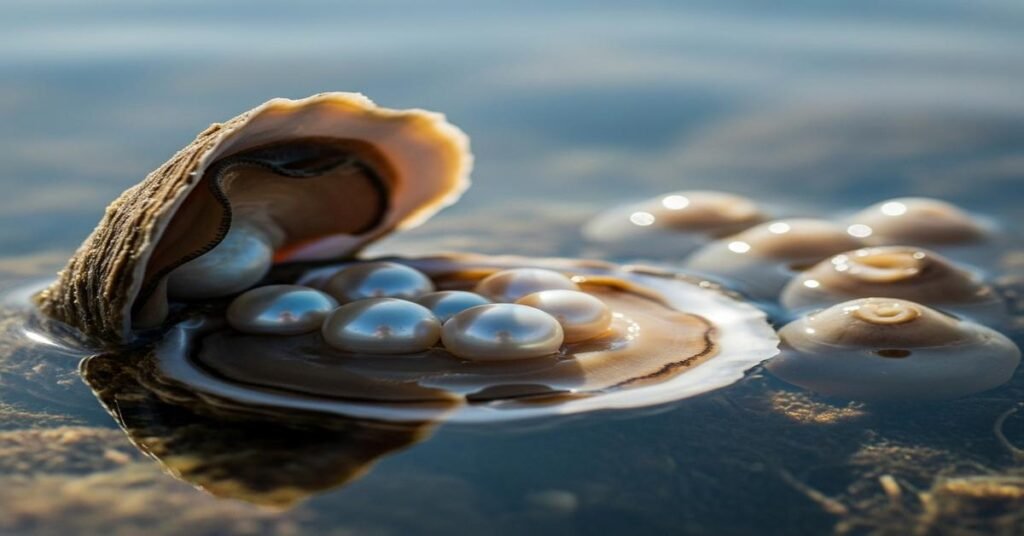Pearl farming can be a reliable, scalable business if you match species, site and market. You don’t need huge capital to start. With the right location, simple gear, and a clear plan for grading and sales, small operations—especially freshwater farms—can turn modest investment into steady returns. Below I explain practical steps, realistic costs, risks and ways to increase value so you can decide whether to start and how to scale.
Why pearl farming can offer low investment with high returns
Pearls are made by mollusks from nacre—no complex feed or chemicals. That lowers recurring input cost. The main value drivers are time, water quality and skill: time in the water to build nacre (18 months to 4+ years), clean productive water, and good grafting or stock management. Because pearls are graded and sold by quality, even small volumes of high-quality pieces can fetch far higher prices than mass-market production, improving ROI.
Which pearls to farm: freshwater vs saltwater
- Freshwater pearls (hyriopsis mussels): Low start-up cost and faster returns. Typical sizes 6–12 mm. Mussels are hardy and can produce multiple pearls per animal. Grow-out often 1.5–3 years. Typical wholesale values can range from $10–$200 per pearl depending on luster, size and shape.
- Saltwater pearls (Akoya, Tahitian, South Sea): Higher revenue per pearl but higher cost and technical skill. Akoya: 7–9 mm; Tahitian: 8–16 mm (black/grey); South Sea: 9–20+ mm (white/gold). Saltwater nuclei require skilled grafting and longer grow-out (2–5 years). A single high-quality South Sea pearl can be worth hundreds to thousands of dollars.
Practical startup steps
- Site selection: Choose sheltered water with stable salinity, low pollution and plankton productivity. For freshwater, lakes and slow rivers with clear water work. For saltwater, protected bays with moderate currents are best. Measure salinity, temperature range and turbidity for a year if possible.
- Decide production model: Buy spat/juveniles and grow out (lowest capital), or run a hatchery and supply spat (higher capex). Most small starters buy seed from an established hatchery and focus on grow-out, grafting (for saltwater) and marketing.
- Get permits and do an environmental check: Farming often needs aquaculture permits, water-use approvals and waste-management plans. Early compliance avoids shutdown risk.
- Learn grafting and husbandry: For saltwater, grafting skill determines percentage of round pearls. Take a short practical course or partner with a technician. For freshwater, learning mantle-tissue insertion and size control still matters.
- Set up infrastructure: Rafts or longlines, baskets, nets and basic onshore workspace. A small freshwater farm can start with a few floats, 100s–thousands of mussels in mesh bags and simple landing facilities.
- Record keeping and monitoring: Track stock by batch, note mortalities, water readings, disease signs and growth rates. Good data reduces surprises and informs marketing decisions.
Costs and a sample business plan
Costs vary by species and location. Below are representative ranges for a small operation.
- Small freshwater starter (5,000 mussels): seed purchase $3,000–$7,000; rafts, nets, small boat $2,000–$5,000; onshore supplies and processing $1,000–$2,000; permits and training $500–$2,000. Annual operating (maintenance, labor, transport) $4,000–$12,000. Total first year: roughly $8,000–$20,000.
- Small saltwater starter (2,000 oysters): seed and grafting services $5,000–$15,000; rafts/longlines $5,000–$20,000; skilled grafting labor/training $2,000–$10,000; permits and onshore processing $2,000–$10,000. First-year total: roughly $20,000–$60,000.
- Hatchery: Building and equipment often >$50,000–$200,000 depending on scale and automation.
Sample conservative revenue example (freshwater): start 5,000 mussels, survival 70% = 3,500 harvestable. If each yields 1.2 marketable pearls = 4,200 pearls; average wholesale $25/piece = $105,000 gross. Subtract operating and one-time costs and you still have substantial profit potential if quality is acceptable. Use conservative survival and price numbers for your business plan.
Quality, grading and how to increase value
Pearl price depends on few measurable variables:
- Size (mm): Bigger pearls sell for more—South Sea 12–15 mm command premium.
- Nacre thickness (mm): For bead-nucleated saltwater pearls, nacre >0.5–1.0 mm is desirable. Freshwater pearls are mostly solid nacre.
- Luster and surface quality: High luster and clean surfaces increase match and value.
- Shape and color: Round and symmetry fetch top prices; unique colors (Tahitian dark tones, South Sea gold) add value.
To increase value: select larger seed and longer grow-out, reduce stress and disease, cull poor performers early, and invest in post-harvest processing (matching, polishing, certified grading, and high-quality settings). Setting in 14k (58.5% Au) or 18k (75% Au) gold or platinum can create retail pieces that multiply raw-pearl revenue several times.
Risks and mitigation
- Disease and parasites: Have quarantine protocols and buy from reputable hatcheries. Rotate stock and avoid overcrowding.
- Environmental shocks: Storms, pollution or algal blooms can kill stock. Diversify sites if possible and maintain early-warning monitoring.
- Market risk: Pearl prices fluctuate. Build multiple sales channels (retail, wholesalers, online) and keep some inventory for timing sales.
- Skill bottleneck: For saltwater, grafting skill is critical. Either develop skills locally or contract experienced technicians.
Sales channels and scaling
- Processing adds value: Investing in drilling, matching and stringing increases revenue. Matched strands sell far better than loose, random pieces.
- Direct retail and branding: Selling finished jewelry or branded strands raises margins versus bulk wholesale.
- Cooperatives and export partners: Small farms can join cooperatives to pool stock and access export markets and quality certification.
- Scale logically: Reinvest early profits to expand stock and infrastructure. Avoid over-extending before you have a consistent production and sales pipeline.
Starting a pearl farm with low investment and aiming for high returns is realistic, especially with freshwater pearls and careful management. Success depends on site choice, consistent husbandry, good grading and choosing the right sales path. Start small, learn the biology and market, and scale when you have repeatable results.
I am G S Sachin, a gemologist with a Diploma in Polished Diamond Grading from KGK Academy, Jaipur. I love writing about jewelry, gems, and diamonds, and I share simple, honest reviews and easy buying tips on JewellersReviews.com to help you choose pieces you’ll love with confidence.

